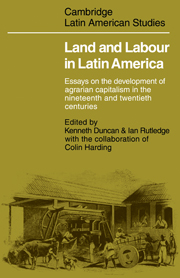 Land and Labour in Latin America
Land and Labour in Latin America Published online by Cambridge University Press: 07 May 2010
In the late nineteenth and early twentieth centuries, Peru – not unlike other Latin American countries – saw a large segment of its economic structure converted into a modern, export-oriented agro-industrial complex, designed to fill the basic raw-material needs of the rapidly industrializing nations of the northern hemisphere. Although Peru did not have a Porfirio Díaz to speed this process along, it nevertheless counted on a ‘científico’ ‘-like Qvilist Party, which steered an economic course rather similar in its broad outlines to the Porfiriato in Mexico. Moreover, Peru, like Mexico, had experienced the economic ravages of a recent foreign occupation, which made it equally vulnerable to the penetration of foreign capital. With its economy languishing in ruins from the Chilean occupation, the nation's entrepreneurial class believed that Peru had little choice but to open its doors and seek out the investment capital that was already accumulating in the north.
And if the time to receive foreign capital in the Latin American periphery seemed right to the ruling class, it was equally propitious from the standpoint of the European and North American metropolis where a second industrial revolution was propelling businessmen abroad in search of markets and raw materials. The upshot for Peru was an ever-increasing flow of foreign investment capital between 1890 and 1930. By 1913 British investments in Peru stood at a high-water mark of $166,000,000 – a figure that was soon surpassed by American capital, which rose from a modest $6,000,000 in 1897 t 0 $63,000,000 in 1914, and again to $200,000,000 in 1930.
To save this book to your Kindle, first ensure no-reply@cambridge.org is added to your Approved Personal Document E-mail List under your Personal Document Settings on the Manage Your Content and Devices page of your Amazon account. Then enter the ‘name’ part of your Kindle email address below. Find out more about saving to your Kindle.
Note you can select to save to either the @free.kindle.com or @kindle.com variations. ‘@free.kindle.com’ emails are free but can only be saved to your device when it is connected to wi-fi. ‘@kindle.com’ emails can be delivered even when you are not connected to wi-fi, but note that service fees apply.
Find out more about the Kindle Personal Document Service.
To save content items to your account, please confirm that you agree to abide by our usage policies. If this is the first time you use this feature, you will be asked to authorise Cambridge Core to connect with your account. Find out more about saving content to Dropbox.
To save content items to your account, please confirm that you agree to abide by our usage policies. If this is the first time you use this feature, you will be asked to authorise Cambridge Core to connect with your account. Find out more about saving content to Google Drive.